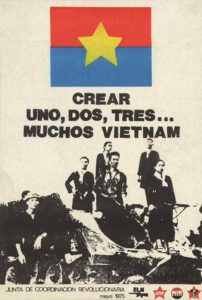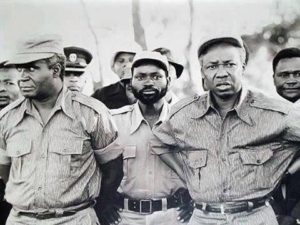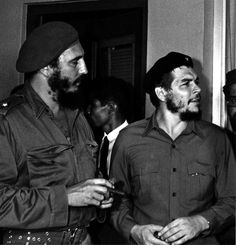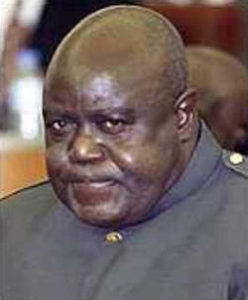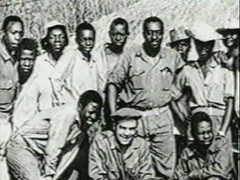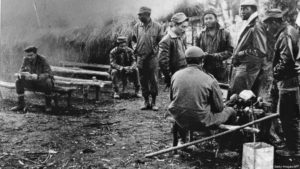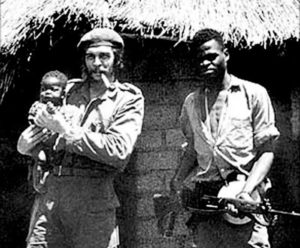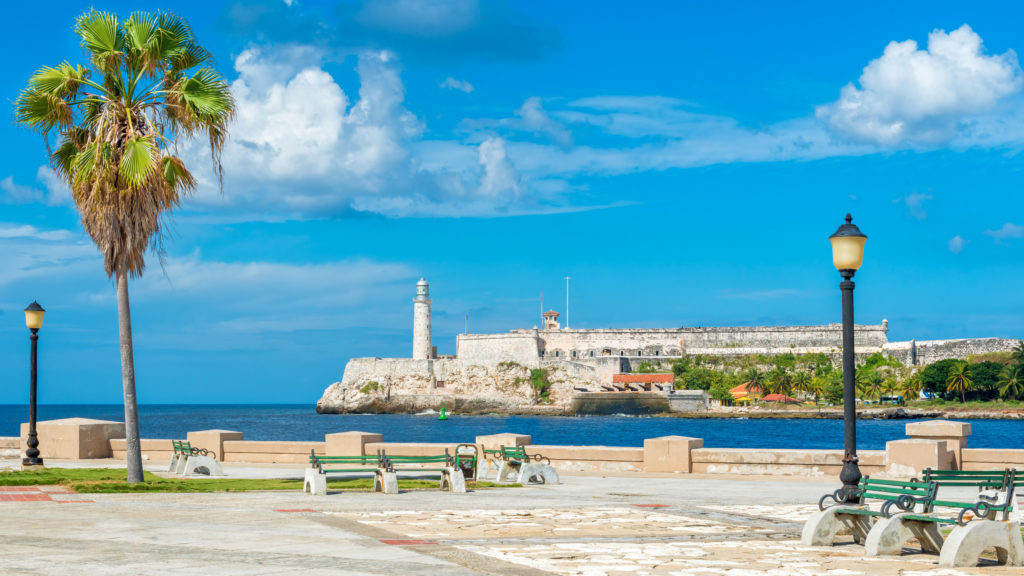 EL “CHE GUEVARA”, SUS CUBANOS Y LA AVENTURA AFRICANA.
EL “CHE GUEVARA”, SUS CUBANOS Y LA AVENTURA AFRICANA.
Fidel Castro tiene que haberse tratado de justificar mucho con su compañero el “Ché” Guevara cuando llegó donde estan.
Esta es la real historia del oportunismo castrista y el espiritu aventurero, soñador de un implacable lider marxista leninista como fue el Che.
Como saben los que le conocimos a ambos, el dictador cubano nunca tuvo amigos, todo el mundo alrededor de el era considerado un prospecto de futuro traidor o al menos alguien que pudiera sabotear su control al mando de la revolución. Cualquier acción o movimiento que hiciera nunca se le podría considerar en beneficio de algo o de alguien sino fuera en afianzar su poder. Repito, su poder.
Durante toda su vida Fidel Castro utilizó a todos a su alrededor para cubrir con pasos medidos los episodios de sus sueños de conquista, entonces en “aras de la dictadura del proletariado” porque entonces convenía a sus intereses. La URSS estaba lejos y él podía maniobrar con los viejos bonzos y organizados seguidores de la doctrina comunista en el ámbito nacional, al mismo tiempo que ganaba tiempo.
Al triunfo de su revolución en 1959 Fidel Castro necesitaba entretener al “Che”, aquel audaz ideólogo, superiormente mas intelectual que el y a quien movió de un lugar a otro dentro del país para más tarde “convencerlo” de la necesidad de muchos Vietnams alrededor el mundo; para entretener a sus enemigos internacionales, asegurandole que él sería el Jefe absoluto de todos los logros revolucionarios. Fidel Castro sabía que el argentino chocaría tarde o temprano con el por la diferencia de sus culturas y ambiciones.
Era el momento de quitárselo de encima. Así es que lo convence para lanzarlo a nuevas conquistas, cosa que fué fácil en ese terreno fértil de las ambiciones personales de su antiguo compañero revolucionario. El Ché nunca comprendió que Fidel fácilmente aparentaría tener todos los medios necesarios en el extranjero para ayudar en esos fantásticos planes “de liberación” y entonces cortar estos, la ayuda prometida, para que “las oligarquías” se ocuparan del ilusionado argentino. Un plan magistral donde Castro tenía todas las de ganar.
PREPARACION DE LA AVENTURA AFRICANA.
Como miembro del gobierno cubano, el Che viajó por África durante los primeros meses de 1965. Se reunió con funcionarios del gobierno y varios líderes de los llamados “movimientos de liberación”. Muchos de estos “luchadores por la libertad” pidieron ayuda en términos de asesoramiento militar y apoyo logístico. Al mismo tiempo, los líderes del movimiento lumumbista en el Congo habían solicitado la posibilidad de enviar a 30 de sus oficiales para estudiar en Cuba. Básicamente, Fidel estuvo de acuerdo, pero cuando se analizaron estas solicitudes, se le ocurrió otra propuesta. Sería más útil enviar oficiales cubanos al Congo para entrenar a los combatientes en el acto. Asi no llamarian tanto la atencion con la gran presencia de los africanos en Cuba y la intervencion en Africa y al mismo tiempo era una asombrosa oportunidad de que el Che ocupara la posición de lider de esa mision fuera de Cuba. Tambien se pensó que no era lo mismo organizar entrenamientos en Cuba que en África. Los congoleños aceptaron la propuesta.
Guevara viaja al África el 1 de Abril de 1965 para apoyar al Movimiento marxista Simba que aprovecha los problemas internos del Congo y que dirige Laurent Kabila; viaja con el nombre de ‘Ramón Benítez’ acompañado del Capt. Cubano negro Víctor Dreke, (que en la aventura toma el alias de ‘Moja’, en Swahili “el Numero Uno”, José Martinez Tamayo (alias Mbili) y otros 126 afro-cubanos. Desembarcan en Tanzania el dia 24 de dicho mes. El entrenamiento lo harian los cubanos, entre los que se encontraban algunos de los que más tarde acompañarian de nuevo al Che en su última aventura, en Bolivia. Serian estos los escogidos para acompañar al Che en lo que seria “el Fiasco” de Africa.
Como el propio ex guerrillero en el Congo Victor Dreke en comentarios despues de su regreso a Cuba en Noviembre de 1965, lo que encuentran en Africa es algo que no tenia ninguna explicación en comparación con lo que le habian hecho creer “No conociamos Africa, el terreno era completamente diferente, habia multitud de animales salvajes -leones, elefantes, culebras venenosas- y tantas enfermedades que nos atacaron para solo decirles algunas. Viviamos a pleno descampado en la selva, sin tiendas de campañas, ni siquiera hamacas, problemas que se agigantaban al no hablar nosotros la lengua, en fin era bien fuerte la situación”, termina diciendo Dreke, ahora un viejo coronel retirado en Cuba.
Desde la llegada los cubanos y principalmente el Che observa como los principales de los considerados “líderes africanos” de liberación pasan el tiempo en lugares de esparcimientos y lupanares en las ciudades, todos ajenos a la lucha que le habian hecho creer encontrarian alli y de la lucha que los cubanos vienen a integrar. Su estancia en África dura varios meses y es uno de los más fuertes golpes que “Ché” recibe en su ilusión ante la realidad que ve allí. Sin darse cuenta de la trama de esta sangrienta novela que Fidel Castro ha tramado.
El Che se comunica con éste tratando de explicarle que “les han vendido un tranvía de grandes dimensiones”… que allí la realidad es otra. En vez de las legiones de revolucionarios africanos dispuestos a seguirlo, sólo existen bandas desconectadas que sobreviven en la selva, todo lo pierden sin combatir, sobran hombres armados y faltan soldados y repite una y otra vez “no podemos liberar solos a un país que no quiere luchar”. Como el comprueba y reconoce en este lugar elegido para sacudir la modorra africana, tampoco hay hambre de tierra, una de las bases ideológicas del dogmatismo de entonces.
Todavia sin darse cuenta del juego de Castro, el “Che” Guevara se critica a si mismo por haber tomado sus propias fantasías revolucionarias como datos reales, está indignado con su propia ligereza para embarcarse en la aventura del Congo conociendo tan poco sobre la profundidad del problema.
Este realismo al que es empujado sin contemplaciones se pierde, sin embargo, en el siguiente capítulo de la vida del Che, cuando se internará para morir en una Bolivia que creía conocer.
Todo se veía tan bien en el papel. Sin embargo, el congoleño considera ser transporte de cargas pesadas como por debajo de su dignidad y se desvía, aburrido, cuando los cubanos tratan de hacer una emboscada al enemigo en ese escenario. Para los supersticiosos guerrilleros africanos cualquier acción tiene que ser apoyado en “Dawa” y pociones mágicas, fomentada por los brujos para la victoria, vaciando entonces sus cargadores en el cielo con los ojos cerrados. Peor aún, ”cada uno de nuestros combatientes habían presenciado con tristeza tropas de asalto que se desvanecen en el momento del combate y tiran sus armas preciosas para huír más rápidamente”, registra Guevara. Sus líderes sobrepasan y eclipsan a los soldados de a pie por estos defectos. Laurent Kabila, el jefe de la revuelta rara vez se dignó a visitar el frente. Y Guevara, protegido de la lluvia torrencial en chozas infestadas de piojos, plagado por la malaria y la disentería, recibe informes de borracheras de Kabila en Dar es Salaam.
Dentro de siete meses de la revolución esta se convirtió en una derrota.
Sin embargo, Guevara es demasiado inteligente para poner toda la culpa a los congoleños. Los cubanos, confiesa, eran demasiado confiados (?) y cometieron errores de aficionado. Llegaron todos mal informado, se espera que estén operando en terreno plano, no montañas. El único traductor de Swahili, el idioma local, es un niño de corta edad, Freddy Ilanga que con el tiempo se salva de la muerte al poder huir con Guevara para Cuba donde aún hoy vive sin poder regresar a su tierra y su familia. La pobre opinión del Che sobre el dirigente congoleño Kabila lo representa en una nota al gobierno de Cuba donde dice ..“nada me llega a convencer que Kabila es el dirigente en este momento de Africa”.
Todavía el Che Guevara no ha reconocido la habilidad de quien lo ha mandado allí y lo que se esconde detrás de éste secreto que nunca supo o quizo comprender y que ya obligado en repetición del fiasco africano lo lleva a la muerte en Bolivia.
En aquel momento mercenarios sudafricanos, junto con operativos cubanos exilados llevados allí por la CIA trabajan junto a las Fuerzas Nacionales del Congo para perseguir a Guevara y su grupo. En una ocasión lo arrinconan cerca de la villa de Fizi en el Lago Tanganika al monitorizar las comunicaciones de los cubanos donde se pueden descubrir con antelación sus planes. Las transmisiones son interceptadas desde un barco de los Estados Unidos, el USNS Private José F. Valdéz (T-AG-169) anclado frente a Dar Es Salaam en el Océano Indico.
En los ultimos dos meses el “Che” y sus cubanos habian sido perseguidos implacablemente por el Coronel Hoare y un grupo de mercenarios Surafricanos contratados por el gobierno del Congo, varios de los cuales conocian bien la contrainsurgencia guerrillera, pero ya el “Che” y sus subordinados estaban convencidos del desastre de la aventura africana y corrian desorganizados y en desbandada.
Ya para Noviembre 20, 1965, enfermo con disentería, sufriendo de fuertes ataques de asma y descorazonado con los siete meses de frustración Guevara deja el Congo con los cubanos sobrevivientes, seis de los originales 12 que habían llegado primero con Victor Dreke estaban muertos, y se aferra a la idea de huír cuando dice.. “es mejor retirarse que morir allí sabiendo los líderes son corruptos; no se puede liberar una nación que no quiere luchar” repite una y otra vez. El elemento humano ha fallado y termina diciendo “Esta es la historia de un Fracaso”, al romper el cerco y marcharse del Congo.
Después de varios meses en recorrido por el extranjero y embajadas cubanas en el exterior, llega Guevara a Cuba en Julio de 1966 de incógnito, solo para estar con su familia, escondido, sin Fidel Castro darlo a conocer públicamente. Fidel consideraba en America Latina a Bolivia como un punto extrategico para extender su ambiciosa influencia. El Che Guevara NO escogió a Bolivia como el lugar ideal.
Solo en el discurso del Primero de Mayo de 1967 en Cuba el Comandante Juan Almeida, entonces Ministro de las Fuerzas Armadas Cubanas dá a conocer que el “Che” Guevara estaba “sirviendo a la revolución en algún lugar de Latinoamérica”… Para el Ché Guevara: Su suerte estaba sellada.
 THE “CHE GUEVARA”, HIS CUBANS AND THE AFRICAN ADVENTURE.
THE “CHE GUEVARA”, HIS CUBANS AND THE AFRICAN ADVENTURE.
Fidel Castro must have tried to tell “Che” Guevara and justify what he did when he arrived at the place where his “compañero” Guevara is.
This is the real story of Castro’s opportunism and the adventurous dreamer spirit of an implacable Marxist Leninist leader like Che.
As those of us who knew both know, the Cuban dictator never had friends, everyone around him was considered a prospect of a future traitor or at least someone who could sabotage his control at the command of the revolution. Any action or move he made could never be considered for the benefit of anything or anyone but to entrench his power. I repeat, its power.
Throughout his life, Fidel Castro used everyone around him to cover with measured steps the episodes of his dreams of conquest, then “for the sake of the dictatorship of the proletariat” because then it was in his interests. The USSR was far away and he was able to maneuver with the old and organized bonzes of communist doctrine at the national level, while also buying time.
At the triumph of his revolution in 1959, Fidel Castro needed to entertain “Che”, that audacious ideologist, superiorly more intellectual than he and who moved from one place to another within the country to later “convince” him of the need of many Vietnams around the world. world; to entertain his international enemies, assuring him that he would be the absolute Chief of all revolutionary achievements. Fidel Castro knew that sooner or later the Argentine would collide with him due to the difference in his cultures and ambitions.
It was time to get it off him. So he convinces him to launch him into new conquests, which was easy in that fertile ground of the personal ambitions of his former revolutionary partner. Ché never understood that Fidel would easily appear to have all the necessary means abroad to help in these fantastic “liberation” plans and then cut these, the promised aid, so that “the oligarchies” would take care of the Argentine illusionist. A masterful plan where Castro had everything to win.
PREPARATION OF THE AFRICAN ADVENTURE.
As a member of the Cuban government, Che traveled through Africa during the first months of 1965. He met with government officials and various leaders of the so-called “liberation movements.” Many of these “freedom fighters” asked for help in terms of military advice and logistical support. At the same time, leaders of the Lumumbista movement in the Congo had requested the possibility of sending 30 of their officers to study in Cuba. Basically, Fidel agreed, but when these requests were analyzed, another proposal occurred to him. It would be more useful to send Cuban officers to the Congo to train the fighters on the spot. Thus they would not attract so much attention with the large presence of Africans in Cuba and the intervention in Africa and at the same time, it was an amazing opportunity for Che to occupy the position of leader of that mission outside Cuba. It was also thought that organizing training in Cuba was not the same as in Africa. The Congolese accepted the proposal.
Guevara travels to Africa on April 1, 1965, to support the Simba Marxist Movement that takes advantage of the internal problems of the Congo and that is led by Laurent Kabila; travels under the name ‘Ramón Benítez’ accompanied by Capt. Black Cuban Víctor Dreke, (who in the adventure takes the alias of ‘Moja’, in Swahili “Number One”), José Martinez Tamayo (alias Mbili) and 126 other Afro-Cubans. They disembark in Tanzania on the 24th of that month. The training would be done by Cubans, among whom were some of those who would later accompany Che again on his last adventure in Bolivia, who would be chosen to accompany Che in what would be “the Fiasco” of Africa.
As the ex-guerrilla in the Congo himself Victor Dreke in comments after his return to Cuba in November 1965, what they find in Africa is something that had no explanation compared to what they had led him to believe “We did not know Africa, The terrain was completely different, there was a multitude of wild animals – lions, elephants, poisonous snakes – and so many diseases that attacked us just to tell you a few. We lived in the open ground in the jungle, without tents, or even hammocks, problems that were growing since we did not speak the language, in short, the situation was very strong, “ends Dreke, now an old retired colonel in Cuba.
Since the arrival of the Cubans and mainly Che, he observes how the main of the considered “African leaders” of liberation spend their time in places of recreation and lupanares in the cities, all oblivious to the fight that they had made him believe they would find there and from the struggle that the Cubans come to integrate. His stay in Africa lasts for several months and is one of the strongest blows that “Ché” receives in his illusion before the reality that he sees there. Without realizing the plot of this bloody novel that Fidel Castro has hatched.
Che communicates with him trying to explain that “they have sold them a large tram” … that there is a different reality. Instead of the legions of African revolutionaries willing to follow him, there are only disconnected gangs that survive in the jungle, they lose everything without fighting, there are plenty of armed men and there are no soldiers, and he repeats again and again “we cannot liberate a country alone that does not he wants to fight ”. As he confirms and recognizes in this place chosen to shake the African drowsiness, there is also no land hunger, one of the ideological bases of dogmatism at the time.
Still unaware of Castro’s game, “Che” Guevara criticizes himself for having taken his own revolutionary fantasies as real data, he is indignant with his own lightness to embark on the adventure of the Congo knowing so little about the depth of the trouble.
This realism to which he is pushed without contemplation is lost, however, in the next chapter of Che’s life, when he will go to die in a Bolivia he thought he knew.
Everything looked so good on paper. However, the Congolese considers himself to be transporting heavy loads as below his dignity and goes astray, bored, when the Cubans try to ambush the enemy in that scenario. For superstitious African guerrillas, any action has to be supported by “Dawa” and magic potions, fostered by warlocks for victory, then emptying their chargers into the sky with their eyes closed. Worse still, “each of our fighters had sadly witnessed assault troops that vanished at the moment of combat and threw down their precious weapons to flee more quickly,” Guevara records. Its leaders outnumber and outshine the foot soldiers for these shortcomings. Laurent Kabila, the leader of the revolt rarely deigned to visit the front. And Guevara, sheltered from torrential rain in lice-infested shacks, plagued by malaria and dysentery, receives reports of Kabila binge drinking in Dar es Salaam.
Within seven months of the revolution, it turned into defeat.
However, Guevara is too smart to put all the blame on the Congolese. The Cubans, he confesses, were too confident (?) And made amateur mistakes. All arrived ill-informed, they are expected to be operating on flat terrain, not mountains. The only translator from Swahili, the local language, is a young boy, Freddy Ilanga who over time is saved from death by being able to flee with Guevara to Cuba where he still lives today without being able to return to his land and family. Che’s poor opinion of the Congolese leader Kabila is represented in a note to the government of Cuba where he says … “nothing convinces me that Kabila is the leader at this time in Africa.”
Che Guevara has still not recognized the ability of the person who sent him there and what is hidden behind this secret that he never knew or wanted to understand and that already forced to repeat the African fiasco leads him to death in Bolivia.
At that time, South African mercenaries, along with exiled Cuban operatives led there by the CIA, work with the Congolese National Forces to persecute Guevara and his group. On one occasion he is cornered near the village of Fizi on Lake Tanganyika by monitoring the communications of the Cubans where their plans can be discovered in advance. The transmissions are intercepted from a United States ship, the USNS Private José F. Valdéz (T-AG-169) anchored off Dar Es Salaam in the Indian Ocean.
In the last two months, “Che” and his Cubans had been relentlessly persecuted by Colonel Hoare and a group of South African mercenaries hired by the Congolese government, several of whom knew the guerrilla counterinsurgency well, but already “Che” and his subordinates were convinced of the disaster of the African adventure and ran disorganized and in disarray.
By November 20, 1965, sick with dysentery, suffering from severe asthma attacks and disheartened with seven months of frustration, Guevara left the Congo with the surviving Cubans, six of the original 12 who had arrived first with Victor Dreke were dead, and he clings to the idea of running away when he says… “it is better to retire than to die there knowing the leaders are corrupt; you cannot liberate a nation that does not want to fight, ”he repeats over and over. The human element has failed and ends by saying “This is the story of a Failure”, breaking the circle around him and leaving the Congo.
After several months on the road abroad and Cuban embassies abroad, Guevara arrived in Cuba in July 1966 incognito, only to be with his family, hidden, without Fidel Castro making it publicly known. Fidel considered Bolivia in Latin America as an extra-strategic point to extend his ambitious influence. Che Guevara did NOT choose Bolivia as the ideal place.
Only in the May Day speech in 1967 in Cuba did Commander Juan Almeida, then Minister of the Cuban Armed Forces, announce that “Che” Guevara was “serving the revolution somewhere in Latin America” … For Ché Guevara: His luck was sealed.
Agencies/ Arnoldo Varona/ Varios/ Internet Photos/ www.TheCubanHistory.com
THE CUBAN HISTORY, HOLLYWOOD.



